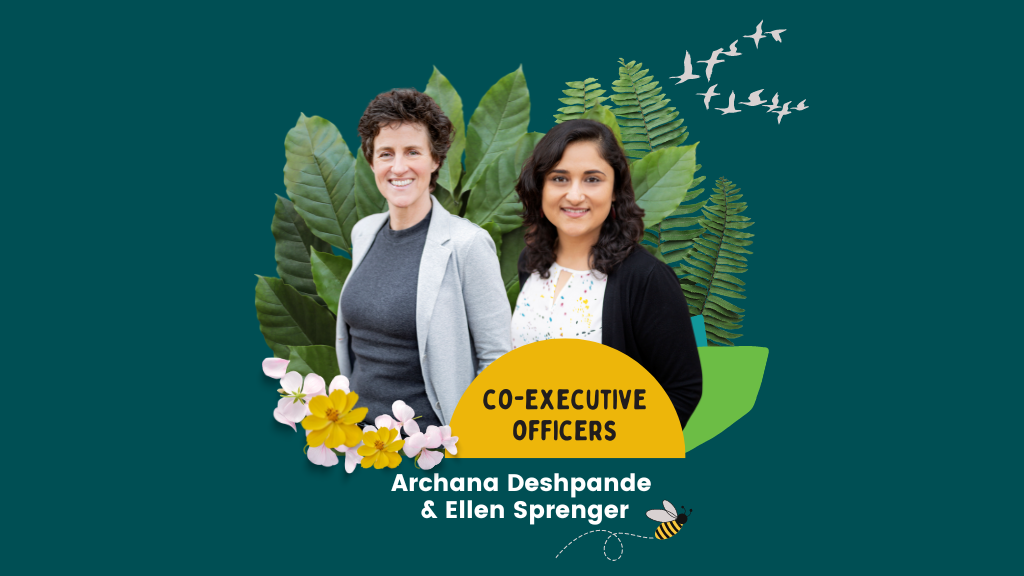A conversation on evolving and shared leadership

Recently we’ve been asking the simple question: What would nature do? When we look to animal mentors like the Canada geese, we see examples of shared responsibility. These geese self-organize into a V-shape formation and because they take turns leading, they’re able to cover 70% more distance together than if they were to fly alone.
Much like the geese, we’re excited to announce that our colleague Archana Deshpande is flying up to the front and together with Ellen Sprenger the pair are now officially Spring’s new Collaborative Executive Officers (Co-CEOs).
Ellen and Archana recently took some time to reflect on this important transition process. I wanted to ask them some questions on how it came about and what we could learn.
How did you both meet?
Ellen: I first met Archana in 2014 at a human rights conference in Morocco, though Archana only officially joined Spring five years later. Archana at one point said to me, “I will join Spring when I’m ready.” I loved that. During those first years we would meet, talk strategy and imagine what Spring could become. When she joined in January of 2019, Spring shifted from being associated with me to a place of growth and global collective leadership. It was a real partnership, from the very beginning.
Why did you decide to transition to this model of shared leadership?
Archana: What we’re trying to do with Spring is come up with a new model of doing and being in this work of supporting and accompanying rights and justice leaders globally. But the world needs titles and as a social enterprise, we never liked the word “chiefs” and the politics that come with it. Co-EOs (which our colleague Caren Cruz came up with) sounds recognizable but also different. We’re going to try it on and might come up with something different along the road. Hopefully as we go, this title will spark some curiosity for others.
As for “Why now?”, Spring has been growing fast and managing more complexity across programs, regions, languages and issues. With this move, we can intentionally leverage and lean on each other's skills and talents to build a self-directed approach to driving change where we can foster shared leadership across our team.
Ellen: We realized we were making all the important decisions together, and that it was time to communicate our partnership to the outside world. It evolved in an organic way. We are very different people and, in many ways, complement each other. But we also challenge each other; there is always room for more learning and growth. Our collaborative approach is dynamic and fun, grounded in trust and respect. But it isn’t just about shared leadership between the two of us. What we are trying to do is share and distribute leadership with the whole team and be leaderFULL together. We are eight people in total, and another 30+ associates with whom we design and deliver programs.
You mentioned you’re very different people — how will this help you lead together?
Archana: We’re very culturally different in how we’ve been brought up, socialized and how we work with others. I’m a very relational person with Indian and Canadian roots, having grown up in a patriarchal family. My experiences have shaped me such that I tend to approach being connected to other people and being of service in a quiet way. It’s very understated but I’m always trying to understand and connect on a personal and deeper level before speaking or sharing my thoughts. It makes me a super listener.
Ellen has mastered listening in another way, a more “let me move into the conversation, get really curious and challenge” kind of way rather than my “let me first hear everything that’s being said and not said” approach.
Ellen: One thing the Dutch do well is express what we think, feel and see. Although this kind of directness can sometimes be experienced as, well, abrupt or jarring, it is also a form of transparency that can lead to greater clarity and direction, especially when people feel safe and connected.
Archana: We see different sides of the whole picture at Spring and that makes a big difference. As we’re constantly engaging in conversations about new programming or doing things we haven’t done before, there’s immeasurable wisdom that Ellen brings from decades of experience working in different contexts. I really value that and equally bring my perspectives and impatience from being younger.
In transitioning to these new roles, what will you need to let go of and what will you need to embrace that may be challenging for you?
Ellen: I so appreciate that Archana is the one who knows everything that’s going on all across Spring. She holds everything together, both the work and the people. After having been that person for the first 15 years of Spring I look forward to having that partner to see and make sense of the system together.
For me, transitioning into this new role means being more intentional about what I should prioritize. Part of being a young elder (I’ve looked into that, it’s a thing) is stepping into a different role. I am recalibrating so to speak. I want to be less out front, more of a resource, and look at where I need to get out of the way.
Archana: I love to know all the details and see the bigger picture. Until recently we were of a size where that was still possible. But we’re now moving to a stage where I need to let go, know enough and give support to other team members to lead and drive in their respective roles.
I’m also hoping this role gives more space for creative and strategic thinking. That’s my jam. I love imagining what’s possible and then getting really practical about how we can make things happen. I’m also looking forward to engaging in external and public conversations: playing a role in sharing stories and learnings from our experiences of accompanying leaders and groups.
For other organizations who are considering adopting shared leadership models, what advice do you have to making this model of co-leadership work?
Archana: Clear communications! I think about our communications approach as “always going to the source” as Ellen says. How do we make sure the whole team is clear on purpose and roles, clear on who to ask for advice, clear on who to go to when issues arise. Naturally, when you grow in any sort of entity like this, if you don’t have that clarity, especially when new things are coming up, it can get really confusing and frustrating for folks. This model really calls for being open and direct, raising issues with the right people when they come up, while being able to hold the boundaries of the role.
Ellen: People in organizations can spend a lot of time talking about what they don’t like or what doesn’t work for them. I see organizations where this takes up 25% of people’s time and energy without any real process for improvement. We work hard to support a culture where frustration or tension can be seen as a source of wisdom; a signal that something needs to change. Bringing things to the surface creates opportunities for learning and growth. We’re trying to cultivate a team spirit where feedback is seen as something important, or even something to look forward to.
Archana: This co-leadership thing isn’t a goal to achieve, it’s a way of being that we’re trying and it requires being open to whatever comes up. We’ll continue seeing this as an evolution as we’re transitioning and figuring out our next stage. Staying open is a key element of this path and I’m just excited to jump in and play.
February 3, 2023

